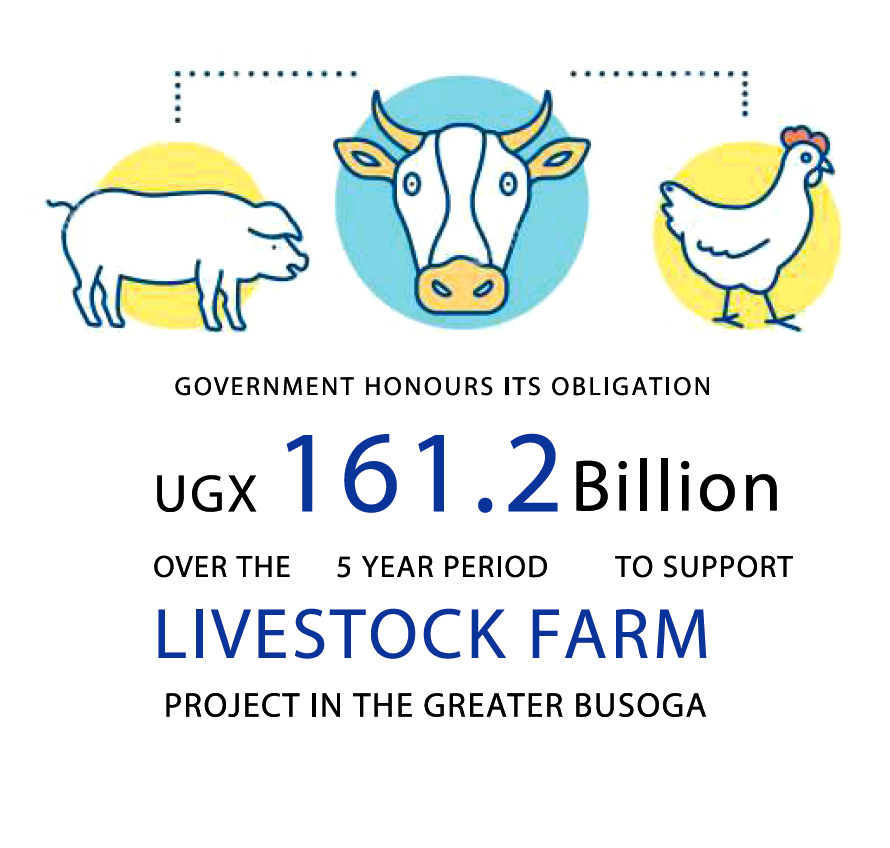Pillar 1
Commercialising Agriculture in the Sub-region
Policy Shift
Restructure the agriculture sector in the sub-region from smallholder-substance farming to commercial cooperative-based farming. This policy is about revitalising farm production and productivity, value addition, market information flow and significant public-private sector partnerships.
Intervention 4: Revolutionising Livestock Farming in the Greater Busoga
Government, through the Ministry of Agriculture, Animal Industry and Fisheries, has approved a fiveyear ‘Revolutionising Livestock Farming project to be implemented in the Greater Busoga’ worth UGX 161.2 billion (USD 43.3 million). The project goal is to increase the production and productivity of small-scale farmers in the greater Busoga subregion through revitalisation of the Kasolwe Stock Ranch to serve as a centre of excellence for livestock breeding and production. The project is designed to ensure increased availability of better quality animal genetic resources through genetic improvement. Animal health will be improved through the control of vector-borne and epidemic diseases, strengthening of extension and regulatory services to deliver quality animal health services, and training farmers in novel techniques of animal husbandry.
The Busoga Consortium fully supports this initiative and through the BDA, commits to be the engine for Busoga-wide sensitisation of the masses to inform them about the project and its intended objectives. In addition, the leadership of the Busoga Consortium undertakes to engage Government to ensure that this project is fully funded and that it provides a platform for agricultural transformation in which individual farmers in the sub-region shift from a highly substance oriented production to specialised scientific livestock production for both the national and regional markets.
This project is designed to provide the following:
Revitalising Kasolwe Stock Ranch to meet international standards to influence quality community breed in the greater Busoga sub-region. The following are the specifics:
- Construction and equipping of an administration block and 20 staff units at Kasolwe Stock Ranch.
- Procurement of one tractor with all its accessories.
- Design and construction of one hay barn.
- Construction of one cattle dip and spray race.
- Improvement of water reticulation system at Kasolwe Stock Ranch and construction of four valley dams and six valley tanks in the Busoga sub-region.
- Establishing a centre of learning and excellence in livestock farming and building partnerships with existing education institutions to link learning to practice.
- Establishing a one-stop centre for livestock inputs.
- Construction of 4 km of farm roads.
- Connecting the Kasolwe Stock Ranch to the national electricity grid.
- Procurement of a 5,000-litre milk cooling system and investment in equipment to add value to milk. This will be used to preserve and add value to milk produced at the farm and that from the communities that will be bought at competitive prices. Through a public-private partnership, the farm will process milk into yoghurt, cheese, butter and ice cream.
- Procurement of a hatchery and brooder – as an extension of rural poultry development. The project will be a launch pad for Busoga-wide community poultry initiatives. A hatchery and brooder with a capacity of 10,000 eggs will be procured and installed at Kasolwe 5,000 litres. Layer, broiler and Kuroiler chicks that will be brooded will be distributed to farmers through existing poultry cooperatives in the Busoga sub-region.
- One fish hatchery, four brooder ponds, 20 fishponds and 50 fish cages will be installed at Kasolwe farm and in various parts of the sub-region. These are planned to jumpstart commercial aquaculture in Busoga. This activity will be implemented through a private-public partnership and with farmers that possess proven leadership skills and the ability to co-share in commercial pond and cade fish production.
-
Establishment of one piggery unit of 5,000 pigs complete with the best breeds and production system. Pigs have the potential to sustain livelihoods among the smallholder farmers because of their characteristic fast growth rate; can be reared on small pieces of land; produce many young ones; can feed on many different crop and animal products and by-products; and have a ready market.
Introduction of 3,000 superior quality goats to the sub-region. These goats will be distributed to farmers across the Busoga sub-region and will be handy for smallholder farmers because they can withstand harsh conditions. - Establishing one model irrigation scheme to demonstrate the importance of irrigation in increasing farm productivity. This scheme will serve the purpose of demonstrating adaptable technology to farmers in the sub-region xvi. Introduction of community breeding services in the sub-region to enhance livestock production and productivity. The Busoga Consortium, in partnership with the project team, will undertake mass sensitisation targeting at least 260,000 households (1,000,000 farmers) to change their perception about artificial insemination.
-
This project will be actualised if the private sector and political society in Busoga have the right information and mechanisms to relay the same information to the citizens. The Busoga Consortium will, therefore, establish a one-stop information centre within its secretariat to provide information to farmers and farmer cooperatives about the opportunities made available through this livestock revitalisation programme. In addition, the realisation of this programme depends on the timely release of funds by Government and mobilisation of the technical resources to get the project going. The Busoga Consortium, through the Busoga Parliamentary Caucus, will be charged with the responsibility of ensuring that Government adheres to timely allocation and release of the funds and that the released funds are accounted for by the project management unit.



